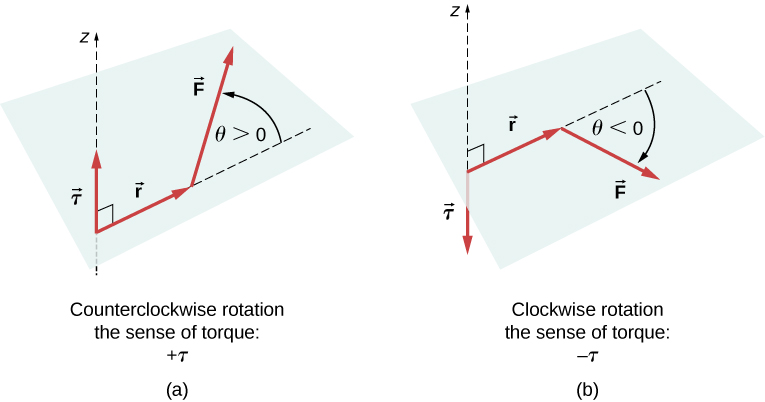| << Chapter < Page | Chapter >> Page > |
where the summation is over all N external forces acting on the body and over their torques. In [link] , we simplified the notation by dropping the subscript z , but we understand here that the summation is over all contributions along the z -axis, which is the axis of rotation. In [link] , the z -component of torque from the force is
where is the length of the lever arm of the force and is the magnitude of the force (as you saw in Fixed-Axis Rotation ). The angle is the angle between vectors and measuring from vector to vector in the counterclockwise direction ( [link] ). When using [link] , we often compute the magnitude of torque and assign its sense as either positive or negative depending on the direction of rotation caused by this torque alone. In [link] , net torque is the sum of terms, with each term computed from [link] , and each term must have the correct sense . Similarly, in [link] , we assign the sign to force components in the x -direction and the sign to components in the x -direction. The same rule must be consistently followed in [link] , when computing force components along the y -axis.

View this demonstration to see two forces act on a rigid square in two dimensions. At all times, the static equilibrium conditions given by [link] through [link] are satisfied. You can vary magnitudes of the forces and their lever arms and observe the effect these changes have on the square.
In many equilibrium situations, one of the forces acting on the body is its weight. In free-body diagrams, the weight vector is attached to the center of gravity of the body. For all practical purposes, the center of gravity is identical to the center of mass, as you learned in Linear Momentum and Collisions on linear momentum and collisions. Only in situations where a body has a large spatial extension so that the gravitational field is nonuniform throughout its volume, are the center of gravity and the center of mass located at different points. In practical situations, however, even objects as large as buildings or cruise ships are located in a uniform gravitational field on Earth’s surface, where the acceleration due to gravity has a constant magnitude of In these situations, the center of gravity is identical to the center of mass. Therefore, throughout this chapter, we use the center of mass (CM) as the point where the weight vector is attached. Recall that the CM has a special physical meaning: When an external force is applied to a body at exactly its CM, the body as a whole undergoes translational motion and such a force does not cause rotation.
When the CM is located off the axis of rotation, a net gravitational torque occurs on an object. Gravitational torque is the torque caused by weight. This gravitational torque may rotate the object if there is no support present to balance it. The magnitude of the gravitational torque depends on how far away from the pivot the CM is located. For example, in the case of a tipping truck ( [link] ), the pivot is located on the line where the tires make contact with the road’s surface. If the CM is located high above the road’s surface, the gravitational torque may be large enough to turn the truck over. Passenger cars with a low-lying CM, close to the pavement, are more resistant to tipping over than are trucks.

Notification Switch
Would you like to follow the 'University physics volume 1' conversation and receive update notifications?